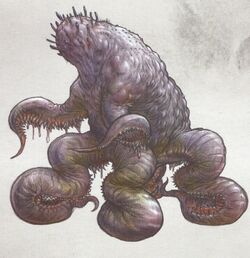"The T'au arrive at your world, with a fleet, tanks, attack craft, Fire Warriors and Battlesuits, and they ask if you want to join in their quest to achieve the Greater Good. Well, that's the way I think it happened with the Galgs. The Galgs were clever enough to say yes, but there are some records that show what happens to those worlds who say no. Sooner or later they either say yes, with their cities burning and their soldiers rotting in their open graves, or are in no position to say anything at all."
- — Inquisitor Oriel

A Galg
The Galgs are a sentient xenos species native to the world of Adummin that has been annexed into the T'au Empire.
History[]
The Galg's homeworld is the planet Adummin in the Segmentum Ultima, not far from the Eastern Fringe. Several Terran centuries before the end of the 41st Millennium the T'au fleet made contact with the Galg's homeworld and offered to let them join the T'au Empire.
The Galgs were excited by the proposal and promptly agreed to pursue the Greater Good.
Since then the Galgs have served the T'au Empire, and some of them operate as auxiliary troops alongside the Fire Caste.
Anatomy and Physiology[]
Galgs are multi-limbed creatures with the shape of amorphous blobs. They have no heads, but clusters of waving eye-like organs, and a set of six tentacle limbs which serve them as both arms and legs.
Galgs are not particularly warlike, nor highly advanced technologically.
Society[]
The Galgs live in palaces that are built deep underground and illuminated by bioluminescent spores. The palaces are called soums and they are constructed under ceremonial mounds called vathries.
Religion[]
The Galgs believe that beneath their soums dwells a malevolent species called the maku, and if Galgs do not lead worthy lives they will descend into the realm of the maku when they die.
Sources[]
- Kill Team (Novel) by Gav Thorpe, Ch. 6
- Liber Xenologis: Observations from a Blackstone Fortress (Sourcebook) by Darius Hinks, pp. 162-163
